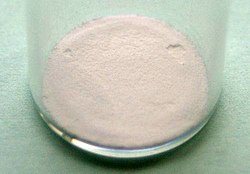 | |
 | |
| Names | |
|---|---|
| IUPAC name Diboron trioxide | |
| Other names boron oxide, diboron trioxide, boron sesquioxide, boric oxide, boria Boric anhydride | |
| Identifiers | |
3D model (JSmol) | |
| ChEBI | |
| ChemSpider | |
| ECHA InfoCard | 100.013.751 |
| EC Number |
|
| 11108 | |
PubChem CID | |
| RTECS number |
|
| UNII | |
CompTox Dashboard (EPA) | |
| |
| |
| Properties | |
| B2O3 | |
| Molar mass | 69.6182 g/mol |
| Appearance | white, glassy solid |
| Density | 2.460 g/cm3, liquid; 2.55 g/cm3, trigonal; |
| Melting point | 450 °C (842 °F; 723 K) (trigonal) 510 °C (tetrahedral) |
| Boiling point | 1,860 °C (3,380 °F; 2,130 K) , [2] sublimes at 1500 °C [3] |
| 1.1 g/100mL (10 °C) 3.3 g/100mL (20 °C) 15.7 g/100mL (100 °C) | |
| Solubility | partially soluble in methanol |
| Acidity (pKa) | ~ 4 |
| −39.0·10−6 cm3/mol | |
| Thermochemistry | |
Heat capacity (C) | 66.9 J/(mol⋅K) |
Std molar entropy (S⦵298) | 80.8 J/(mol⋅K) |
Std enthalpy of formation (ΔfH⦵298) | −1254 kJ/mol |
Gibbs free energy (ΔfG⦵) | −832 kJ/mol |
| Hazards | |
| Occupational safety and health (OHS/OSH): | |
Main hazards | Irritant [4] |
| GHS labelling: | |
 | |
| Danger | |
| H360FD | |
| P201, P202, P281, P308+P313, P405, P501 | |
| NFPA 704 (fire diamond) | |
| Flash point | noncombustible |
| Lethal dose or concentration (LD, LC): | |
LD50 (median dose) | 3163 mg/kg (oral, mouse) [5] |
| NIOSH (US health exposure limits): | |
PEL (Permissible) | TWA 15 mg/m3 [4] |
REL (Recommended) | TWA 10 mg/m3 [4] |
IDLH (Immediate danger) | 2000 mg/m3 [4] |
| Supplementary data page | |
| Boron trioxide (data page) | |
Except where otherwise noted, data are given for materials in their standard state (at 25 °C [77 °F], 100 kPa). | |
Boron trioxide or diboron trioxide is the oxide of boron with the formula B2O3. It is a colorless transparent solid, almost always glassy (amorphous), which can be crystallized only with great difficulty. It is also called boric oxide [6] or boria. [7] It has many important industrial applications, chiefly in ceramics as a flux for glazes and enamels and in the production of glasses.
